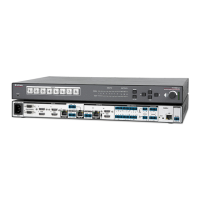IN1608 xi Scaling Presentation Switcher • Operation 44
RS-232 Insertion
The twisted pair input and output ports allow you to insert RS-232 control signals onto the
same cable that carries video and audio to extend them to the Over TP port on a connected
endpoint (see figure 34 on the next page and figure 35 on page 46). The control signals
can be inserted two ways:
• Ethernet to RS-232 insertion (see “Ethernet to RS-232 Insertion”) — A control signal
applied to the IN1608 xi LAN port can be routed to the RS-232 port of any connected
twisted pair device.
• Captive screw insertion (see Captive Screw Signal Insertion on page 46) — A
control signal applied to an RS-232 captive screw port is tied directly to the same-
numbered TP port. RS-232 input port 7 is tied to TP port 7 only, and 8 is tied to 8.
You must physically connect a cable connected to the captive screw connector where a
control signal is to be inserted.
The insert inputs and outputs, whether inserted via Ethernet or captive screw connectors,
can support up to a 115K baud rate.
Enabling Ethernet and Captive Screw Insertion
For a DTP port to distribute the inserted signal, it must be enabled for either Ethernet
insertion or captive screw insertion (default). Use one of the following methods to make this
selection:
• Product Configuration Software (see the IN1606 and IN1608 Series PCS Help file)
• SIS commands (see the Ethernet to RS-232 Insertion SIS commands, beginning on
page 74)
• Internal web pages (see RS-232 Insertion panel (inputs 7 and 8 and output 1C
only) on page 123)
Ethernet to RS-232 Insertion
Figure 34 is an example of a typical Ethernet to RS-232 insertion, in which an Extron IPCP
module provides control of an HD camera via the IN1608 xi and a DTP HDMI 4K 230
transmitter.
Configure this type of insertion as follows (see figure 34):
1. Connect a TP cable from the IPCP module to the LAN port, directly or via a network.
2. If necessary, enable the port (input port 7 in this example) for Ethernet (see “Enabling
Ethernet and Captive Screw Insertion”).
3. If necessary to match the device to be controlled, configure the port RS-232 protocol
(baud rate, parity, data bits, and stop bits) (see RS-232 protocol on page 46).
4. Connect the TP cable to the endpoint as usual.
5. Connect a serial cable from the endpoint to the device to be controlled.

